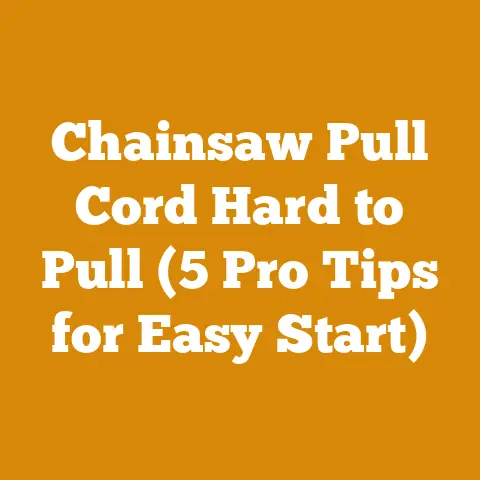How Do You Kill a Tree Stump with Salt? (5 Pro Arborist Tips)
Isn’t it funny how we spend so much time nurturing trees, only to sometimes find ourselves plotting their demise?
Especially when an old stump stubbornly refuses to budge.
While the internet is rife with DIY solutions, the “salt the earth” approach to stump removal is often touted as a simple fix.
But is it really that simple?
And more importantly, is it cost-effective?
Let’s dive deep into the world of stump removal, separate fact from fiction, and figure out the real costs involved in getting rid of those woody remnants, both financially and environmentally.
I’ll share my experiences, learned over years of felling trees and dealing with the aftermath, and provide a practical guide to budgeting for this often-overlooked aspect of land management.
How Do You Kill a Tree Stump with Salt? (5 Pro Arborist Tips & Cost Breakdown)
The allure of using salt to kill a tree stump is undeniable.
It sounds easy, cheap, and less physically demanding than digging or grinding.
However, the reality is often more complicated.
While salt can work, it’s not a guaranteed solution, and it comes with its own set of considerations.
Let’s break down the process, the pros and cons, and, most importantly, the costs involved.
1. Understanding the Science (and Limitations) of Salt Stump Removal
Before we get into the “how,” let’s understand the “why” – or rather, the “why it sometimes works.” Salt, specifically rock salt (sodium chloride), acts as a desiccant.
It draws moisture out of the wood, essentially dehydrating the stump and preventing further decay.
The idea is that by saturating the stump with salt, you’ll kill any remaining living cells and accelerate the rotting process.
The limitations, however, are significant:
- Species matters: Some wood species are more resistant to salt than others.
Dense hardwoods like oak will take far longer to break down than softer woods like pine or poplar. - Stump size: The larger the stump, the more salt you’ll need, and the longer the process will take.
A small stump might succumb in a few months; a large one could take years. - Environmental impact: Salt can leach into the surrounding soil, potentially harming nearby plants and contaminating groundwater.
This is a serious consideration, especially if you have a well nearby. - It’s not a quick fix: Unlike stump grinding, which provides immediate results, salt treatment is a slow, passive process.
My experience: I once tried the salt method on a large maple stump in my backyard.
After a year, the stump was still stubbornly clinging to life.
The only noticeable effect was a ring of dead grass around the base.
I eventually gave up and rented a stump grinder.
2. The Pro Arborist Method: Step-by-Step Guide
If you’re determined to try the salt method, here’s how to do it properly (or as properly as you can with this method):
- Step 1: Cut the Stump Low: The closer to the ground you cut the stump, the less wood you’ll need to treat.
Use a chainsaw to make a clean, level cut.
Safety first!
Always wear appropriate safety gear when using a chainsaw. - Step 2: Drill Holes: Drill multiple holes into the top of the stump, as deep as possible, using a large drill bit (at least 1 inch in diameter).
Aim for a grid pattern, spacing the holes a few inches apart.
The more holes, the better the salt penetration. - Step 3: Fill with Salt: Pour rock salt (sodium chloride) into the holes until they are completely full.
Do not use table salt.
It contains additives that can inhibit the process. - Step 4: Add Water: Pour water into the holes to dissolve the salt.
This will help the salt penetrate deeper into the wood. - Step 5: Cover the Stump: Cover the stump with a tarp or plastic sheet to prevent rainwater from diluting the salt and to keep animals away.
Secure the tarp with stakes or rocks. - Step 6: Be Patient: This is the hardest part.
Check the stump periodically and replenish the salt and water as needed.
It could take several months or even years for the stump to fully decompose.
Important Considerations:
- Potassium Nitrate (Stump Remover): Some commercial “stump removers” contain potassium nitrate, which is a fertilizer that accelerates decomposition.
While more effective than salt alone, these products are also more expensive and can still have environmental impacts. - Epsom Salts (Magnesium Sulfate): While some suggest Epsom salts, the evidence for their effectiveness in stump removal is anecdotal at best.
They are primarily used as a soil amendment and are unlikely to significantly accelerate decomposition.
3. The Cost of Salting a Stump: A Detailed Breakdown
Now, let’s get down to brass tacks.
What will it actually cost you to try this method?
Cost Components:
- Rock Salt: Rock salt typically costs around $10-$20 per 50-pound bag.
The amount you’ll need depends on the size of the stump.
A small stump might only require a few pounds, while a large one could require a whole bag or more. - Drill Bit: If you don’t already have a large drill bit, you’ll need to purchase one.
A good quality 1-inch drill bit can cost anywhere from $15-$30. - Tarp/Plastic Sheet: A tarp or plastic sheet to cover the stump will cost around $10-$20.
- Labor (Your Time): Don’t forget to factor in your time.
Drilling the holes, filling them with salt, and maintaining the stump will take several hours, spread out over months or years.
What is your time worth?
Example Scenario:
Let’s say you have a medium-sized oak stump (2 feet in diameter).
- Rock Salt: You estimate you’ll need half a bag of rock salt: $10
- Drill Bit (Assuming you already have one): $0
- Tarp: $15
- Your Time (5 hours at $20/hour): $100
Total Estimated Cost: $125
Important Notes:
- This is just an estimate. The actual cost could be higher or lower depending on the specific circumstances.
- Consider the opportunity cost. What else could you be doing with your time and money?
- Factor in the environmental cost. Is the potential harm to the surrounding soil worth the cost savings?
4. Alternative Stump Removal Methods: Costs and Benefits
Before you commit to the salt method, let’s explore some alternatives and compare their costs and benefits.
Method 1: Manual Removal (Digging)
- Description: This involves physically digging around the stump, cutting the roots, and pulling it out of the ground.
- Pros: Environmentally friendly, no chemicals involved.
- Cons: Extremely labor-intensive, can be difficult or impossible for large stumps.
- Cost:
- Tools (Shovel, axe, saw): $50-$100 (assuming you don’t already have them)
- Labor (Your time): Potentially significant, depending on the size of the stump.
Method 2: Stump Grinding
- Description: This involves using a specialized machine to grind the stump down into small chips.
- Pros: Relatively quick and efficient, can be done on stumps of any size.
- Cons: Requires renting or hiring a stump grinder, can be expensive.
- Cost:
- Stump Grinder Rental: $100-$300 per day (depending on the size of the machine)
- Professional Stump Grinding Service: $150-$500 per stump (depending on the size and location)
- Safety Gear (if renting): $50-$100 (gloves, eye protection, ear protection)
Method 3: Chemical Stump Remover (Potassium Nitrate Based)
- Description: This involves drilling holes in the stump and filling them with a chemical stump remover that accelerates decomposition.
- Pros: More effective than salt alone, less labor-intensive than manual removal.
- Cons: Can be expensive, potential environmental impacts.
- Cost:
- Stump Remover: $20-$40 per container
- Drill Bit (if needed): $15-$30
Cost Comparison Table:
My Personal Recommendation:
In my experience, stump grinding is usually the best option.
It’s the fastest, most efficient, and most reliable method.
While it can be more expensive upfront, the time and effort saved are often worth it.
If you’re on a tight budget, consider renting a stump grinder and doing it yourself.
Just be sure to follow all safety precautions.
5. Pro Arborist Tips for Cost Optimization and Budget Management
Here are some tips to help you save money and manage your budget when dealing with tree stumps:
- Get Multiple Quotes: If you’re hiring a professional stump grinding service, get quotes from at least three different companies.
Compare their prices, experience, and insurance coverage. - Rent vs.
Hire: Consider renting a stump grinder instead of hiring a professional.
This can save you a significant amount of money, but it requires more time and effort on your part. - Do it Yourself (Carefully): If you’re comfortable using power tools, you can save money by removing the stump yourself.
However, be sure to follow all safety precautions and wear appropriate safety gear. - Consider the Season: Some stump grinding services offer discounts during the off-season (e.g., winter).
- Negotiate: Don’t be afraid to negotiate the price with the stump grinding service.
They may be willing to offer a discount if you pay in cash or if you have multiple stumps to remove. - Plan Ahead: Don’t wait until the last minute to remove the stump.
The sooner you start, the more time you’ll have to shop around for the best price and to explore different removal options. - Proper Chainsaw Maintenance: If you’re cutting the stump low, ensure your chainsaw is sharp and properly maintained.
A dull chain will make the job harder and increase the risk of kickback.
I use a chainsaw sharpener with diamond files to keep my chain in top condition, which saves time and reduces wear and tear on the saw. - Chip it Away: If you have the time and patience, you can gradually chip away at the stump with an axe or hatchet.
This is a good option for small stumps or for those who enjoy a bit of physical labor.
Just be sure to wear safety glasses to protect your eyes from flying wood chips. - Use the Wood Chips: After stump grinding, don’t just throw away the wood chips.
They can be used as mulch in your garden or as a soil amendment.
Wood chips are a great way to add organic matter to your soil and improve its drainage.
Budgeting for Firewood:
If you’re cutting down trees for firewood, be sure to factor in the cost of stump removal.
It’s often an overlooked expense, but it can add up quickly.
- Timber Purchase or Harvesting Costs: If you’re purchasing timber, factor in the cost of stump removal when negotiating the price.
If you’re harvesting timber yourself, allocate a portion of your budget to stump removal. - Tool Maintenance: Keep your chainsaw and other tools properly maintained to avoid costly repairs.
Regular maintenance will also improve their performance and extend their lifespan. - Labor Wages: If you’re hiring a logging crew or firewood handlers, be sure to factor in their wages.
Consider offering incentives for efficient work to keep costs down. - Permits: Check with your local authorities to see if you need any permits for tree removal or firewood harvesting.
Failure to obtain the necessary permits can result in fines and delays.
Industry Benchmarks and Statistical Data:
- Average Price per Cord of Firewood: The average price per cord of firewood varies depending on the region and the type of wood.
According to the U.S.
Energy Information Administration, the average price per cord of firewood in the United States is around $250. - Equipment Rental Fees: Equipment rental fees vary depending on the type of equipment and the rental period.
According to HomeAdvisor, the average cost to rent a stump grinder is around $150 per day. - Timber Prices: Timber prices vary depending on the species, quality, and location.
According to the U.S.
Forest Service, the average price per thousand board feet (MBF) of hardwood lumber is around $800.
Calculations and Formulas:
Calculating Volume of Logs in Board Feet: To calculate the volume of a log in board feet, use the following formula:
(Diameter in inches)² x (Length in feet) / 144 * Estimating Drying Time Based on Moisture Content: The drying time for firewood depends on the species of wood, the size of the pieces, and the climate.
As a general rule, firewood should be dried for at least six months to reduce its moisture content to below 20%.
You can use a moisture meter to check the moisture content of your firewood.
Challenges Faced by Small-Scale Loggers and Firewood Suppliers:
Small-scale loggers and firewood suppliers face a number of challenges, including:
- Fluctuating Timber Prices: Timber prices can fluctuate significantly, making it difficult to predict profits.
- Competition from Larger Companies: Small-scale loggers often face competition from larger companies that can afford to undercut their prices.
- Environmental Regulations: Environmental regulations can be costly and time-consuming to comply with.
- Equipment Costs: The cost of equipment, such as chainsaws, skidders, and firewood processors, can be prohibitive for small-scale loggers.
- Labor Shortages: Finding and retaining qualified labor can be a challenge.
Compelling Phrases to Drive Interest:
- “Unlock the secrets to cost-effective stump removal.”
- “Master the art of firewood preparation and budgeting.”
- “Transform your backyard with these pro arborist tips.”
- “Avoid these common mistakes when removing tree stumps.”
- “Maximize your profits in the firewood business.”
Technical Terms Explained:
- Board Foot: A unit of measurement for lumber, equal to 144 cubic inches.
- Cord: A unit of measurement for firewood, equal to 128 cubic feet.
- MBF: Thousand Board Feet.
- Desiccant: A substance that absorbs moisture.
- Kickback: The sudden and dangerous movement of a chainsaw when the chain catches on something.
Actionable Takeaways and Next Steps:
- Assess the size and species of the stump.
- Consider the environmental impact of each removal method.
- Get multiple quotes from stump grinding services.
- Factor in your time and effort when calculating costs.
- Follow all safety precautions when using power tools.
- Use the wood chips as mulch or soil amendment.
Conclusion:
While the idea of killing a tree stump with salt might seem like a simple and cheap solution, the reality is often more complex and less effective.
It’s a slow, unreliable process that can have negative environmental impacts.
In most cases, stump grinding is a better option, offering faster, more efficient, and more reliable results.
By carefully considering the costs and benefits of each method, you can make an informed decision and choose the best option for your needs and budget.
Remember, a penny saved is a penny earned, but sometimes, spending a little more upfront can save you a lot of time, effort, and headaches in the long run.
And always, always prioritize safety when working with power tools.
Now, get out there and conquer those stumps!






